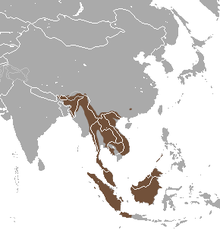Binturong
| Binturong | ||||||||||||
|---|---|---|---|---|---|---|---|---|---|---|---|---|

Binturong ( Arctictis binturong ) |
||||||||||||
| Systematics | ||||||||||||
|
||||||||||||
| Scientific name of the genus | ||||||||||||
| Arctictis | ||||||||||||
| Temminck , 1824 | ||||||||||||
| Scientific name of the species | ||||||||||||
| Arctictis binturong | ||||||||||||
| ( Raffles , 1821) |
The binturong ( Arctictis binturong ), also known as the marten bear , is a species of predator from the family of the crawling cats (Viverridae). Because of his appearance he was previously placed with the small bears , but in reality he is a very different crawling cat.
features
The binturong is plump and short-legged, its fur is coarse and long, especially on the tail. It is mostly dark gray or black in color, the head is often greyish. The head is characterized by the long, white whisker hairs and the long tufts of ears. As the only predator besides the wrapped bear and the only higher mammal in the Old World, it has a prehensile tail. Binturongs reach a head body length of 61 to 96 centimeters, in addition there are 56 to 89 centimeters of tail; thus it is the largest species from the palm roller subfamily . Its weight varies from 9 to 14, in exceptional cases up to 20 kilograms.
The smell left by marten bears is likely to be particularly noticeable to humans. The substance 2-acetyl-1-pyrroline , which occurs in the urine of animals, reminds people of the smell of popcorn. In fact, this substance occurs in this very same.
distribution and habitat

Binturongs live in Southeast Asia . Their distribution area extends from India over the Southeast Asian mainland to the islands of Sumatra , Java , Borneo and Palawan . Their habitat are dense forests, predominantly tropical rainforests .
Way of life
Binturongs are nocturnal and live mainly as tree dwellers. Your movements are slow and deliberate; they do not jump, but they can climb well with the help of their strong legs, sharp claws and prehensile tail. They are also reported to be good at swimming and diving. On the ground he acts like a bear with his whole sole, which is a very unusual way of locomotion for a crawling cat.
Binturongs live alone or in small groups consisting of a couple and their offspring. Females are dominant within these groups.
nutrition
The main food of the binturongs are fruits. The proportion of plant-based food in the total food is probably higher than that of all other crawling cats. In addition, they also eat insects and birds, go on carrion and rob bird's nests. Fish also form part of the diet.
Reproduction
The female can give birth to offspring twice a year. After a gestation period of around 90 days, it gives birth to one to six (on average two or three) young animals. Even after birth, the female tolerates her partner in the vicinity, which is unusual among crawling cats. Young animals eat solid food for the first time after six to eight weeks and reproduce for the first time at around 2.5 years of age. The highest known age of a binturong in captivity was 25 years.
Binturongs and people
In some regions, binturongs are kept as pets ; they should be easy to tame and very trusting animals. Their meat is considered a delicacy in some places, and some parts of the body are used in traditional medicine. Due to the sharp decline in the population of 30 percent in the last 30 years (three generations), the IUCN classifies the Binturong as endangered ("vulnerable").
literature
- Ronald M. Nowak: Walker's Mammals of the World . 6th edition. Johns Hopkins University Press, Baltimore 1999, ISBN 0-8018-5789-9 (English).
Web links
- Arctictis binturong in the Red List of Threatened Species of the IUCN 2016. Posted by: Willcox, DHA, Chutipong, W. Gray, TNE, Cheyne, S., Semiadi, G., Rahman, H., Coudrat, CNZ, Jennings, A ., Ghimirey, Y., Ross, J., Fredriksson, G. & Tilker, A., 2016. Retrieved July 6, 2019.
Individual evidence
- ↑ tz, "Why the Marten Bear Smells Like Popcorn", April 15, 2016
